Introduction
For my final major project, I have decided to create a Student-Led Creative Agency called STRIVE. As a recent graduate, I have noticed first-hand the difficulty in securing a full-time job within the creative industry. Many companies expect 2-3 years of experience for a junior role, which most students don’t have, this means many recent graduates are unable to find jobs even though they have achieved a degree. To combat this issue, I wanted to provide students with an opportunity to work with real-life clients while studying to not only develop their portfolios but increase their experiences. Therefore increasing the chance of securing a full-time role sooner.
Even though the concept sounds easy, below is my process of fully understanding how the agency would work and become successful. In this project, I analyse the risks and possible challenges of this proposal with solutions to ensure success. Furthermore, I have created a brand strategy of how the agency would stand out in the market. While implementing my previous research proposal: The Impact of Visual Perception and Memory Retention on User Interaction in Digital Design Interfaces. I’ve used this research proposal and methodology as a foundation for the website design and user testing to ensure memorability for users.
Below, you can access the the Branding side of the project and how I created a memorable website. Whilst if you keep scrolling, you can read about the business development and the back end of how I managed this project.
“More needs to be done to bridge the gap between work and study. I often find that graduates aren’t ‘industry-ready.”
Cecilia Righini (Founder of Studio Lutalica)
In the article; How can the industry make design careers seem more accessible? Bamford, (2023) collected a variety of interviews with founders and CEOs of successful design agencies. They were asked to comment on the current issues graduates are facing in the job market.
This article summarised the known problem of design graduates struggling to find the experience to land their first full-time role. Even though the industry promotes design degrees, many students are faced with the reality of not having enough experience to present to future employers. The majority of the founders highlighted this, and argued that graduates should be supported to gather the experience to become “industry-ready.” Therefore finding it easier to enter a full-time position and start their careers.
How can we bridge the gap?

The concept of this project is to create a student led creative agency, based in Winchester. The agency would create an opportunity for students to work on briefs set out by real companies and experience the design industry. This not only allows students to gain experience but shows companies the potential and skills of graduate designers. Ultimately creating a more accessible job market.
Aim and Objectives
Aim:
The aim is to create a Student-Led creative design agency, that assist students and recent graduates in gaining experience to be able to secure full-time positions in the industry
Objective 1:
To conduct secondary research into the industry, To understand the problems the agency may face and provide solutions.
Objective 2 :
To create an effect Brand Bible that encompasses an effective logo and branding identify that is innovative and eye-catching.
Objective 3:
To create a memorable website design, based on user testing from the previous research proposal methodology.
Time Management
Below is the Gannt Chart that I created for this project. As this is the longest project I have created, it was important to separate this chart into separate sections. This not only would reduce feeling overwhelmed but also assist in creating milestones at the end of every month. I plotted the light blue boxes at the start of this poject and plotted the dark blue outlined boxes throughout the project. This assited in ensuring that i was keeping ontrack with the origional plan.
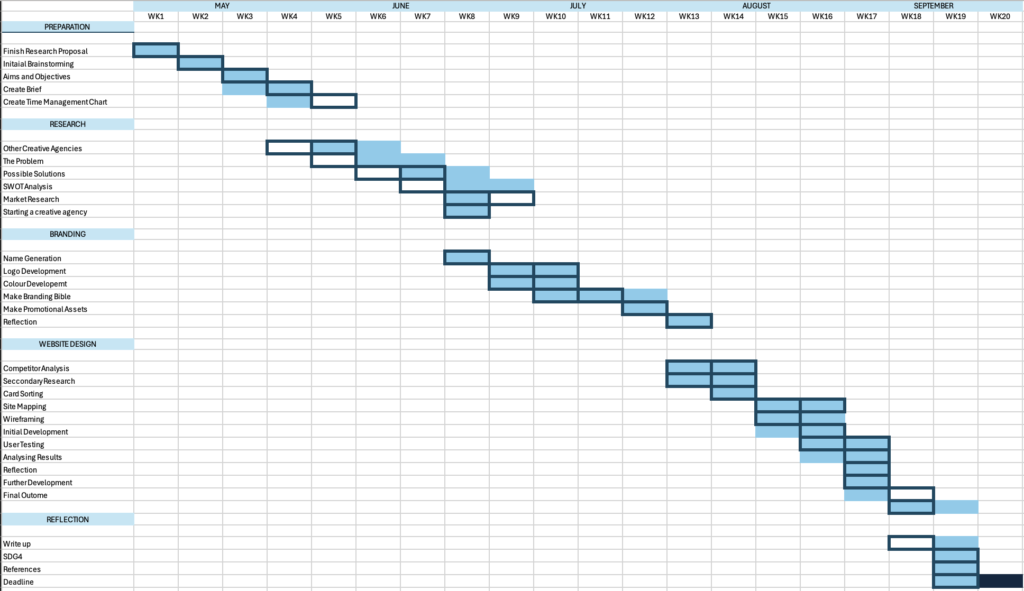
The first month aimed to complete my research proposal and also start creating the preparation. In June I wnated to focus on seccondary research as this was going to be the core fundementals of why I was creating the project, which would then lead into July where i would start creating the Brand Strategy. At the end of August, I aimed to complete the Brand Bible which assisted in creating the website design at the start of september.
Ultimately the Gannt Chart sucsesfully enabled me to stay focused throughout the summer, expecially as this porject was highly independant.
Starting a creative agency
Below is a blog where, I met the founder of the design agency Black Eye Project where he shone insight into what its like starting a creative agency
Examples of Student-Led Creative Agencies
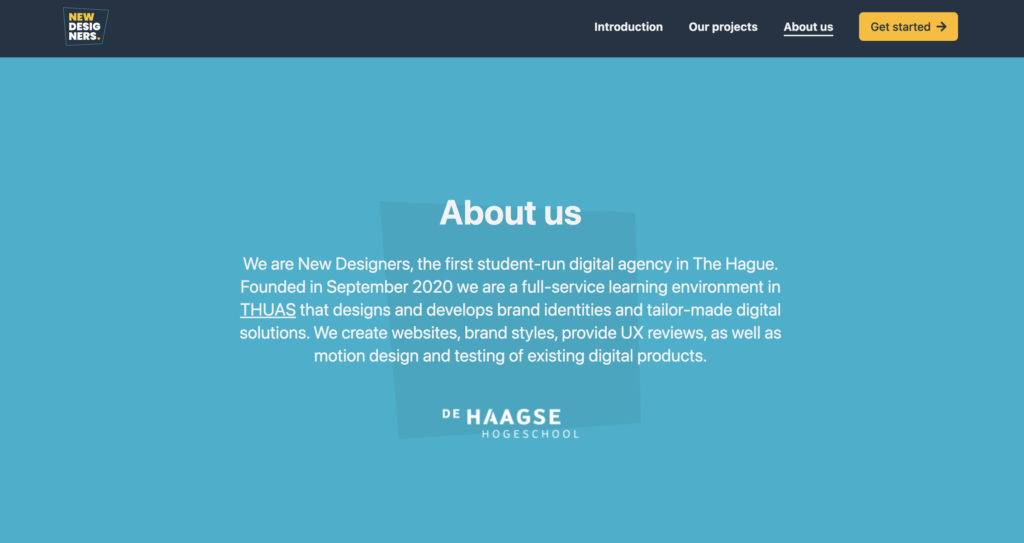
New designers.agency. (2024). is a student-run digital agency based in The Hague, Netherlands. They are a full service agency providing a learning environment for students at The Hague University of Applied Sciences (THUAS).
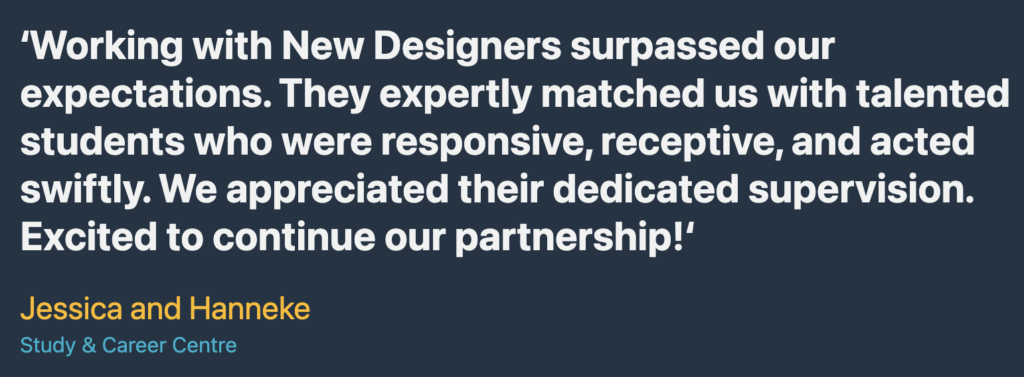
The unique aspect of New Designers is that it is completely student-led, giving students hands-on experience with real clients while they are still in school. This experience is meant to bridge the gap between education and industry, enabling students to build a portfolio and develop their professional skills before graduation. The agency works with local and international clients, offering custom solutions like branding packages, website creation, and even video production.
New Designers has achieved success due to several key factors that leverage both their unique position as a student-led agency and the quality of work they deliver. Here’s why they are successful:
- Real-World Experience for Students
- Cost-Effective Solutions for Clients
- University Support and Resources
- Diverse Portfolio and Clientele
- Effective Mentorship and Collaboration
- Focus on Digital Skills and Innovation
SWOT Analysis and USP
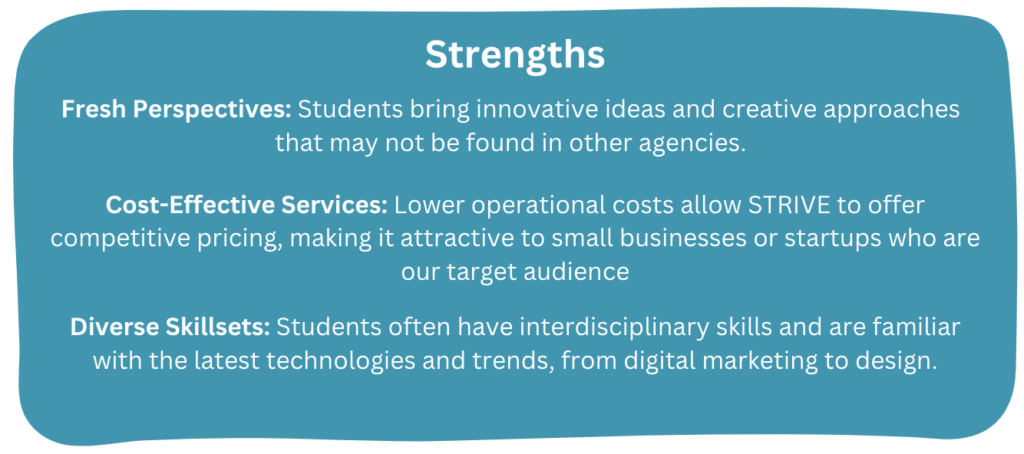
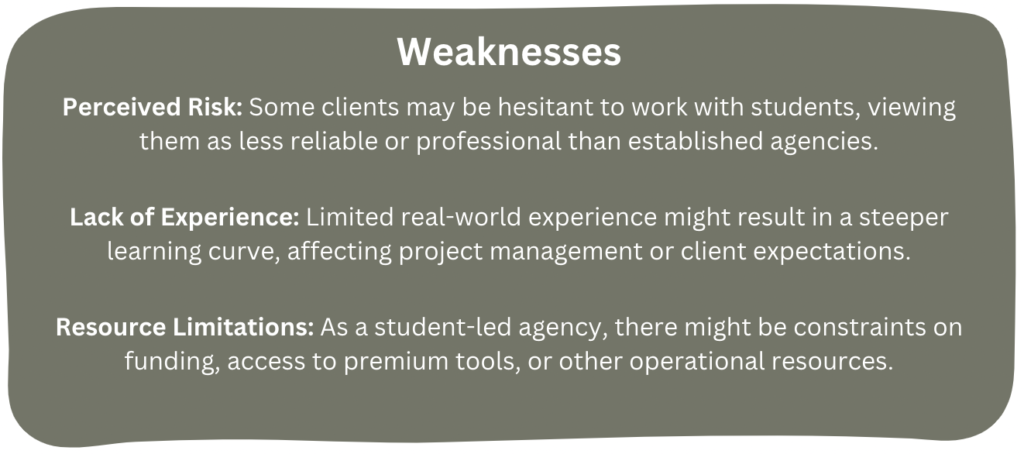
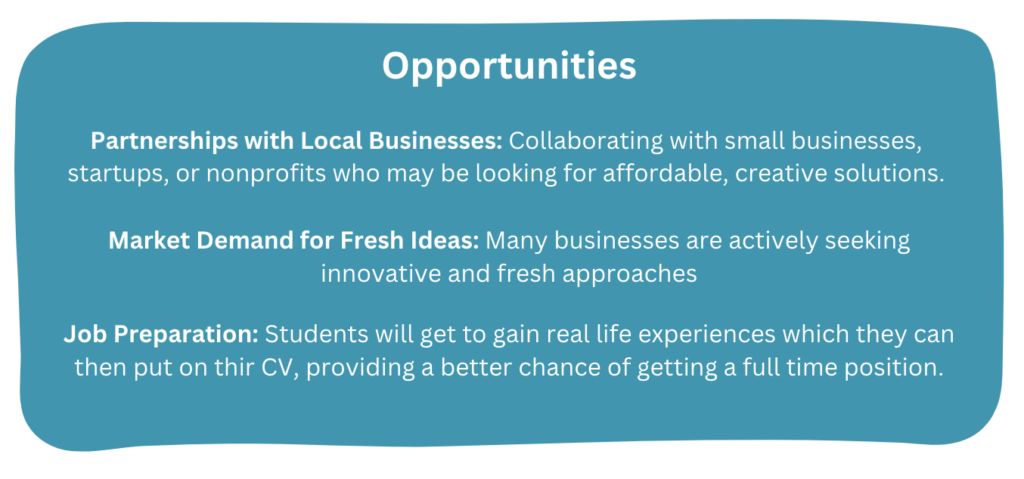
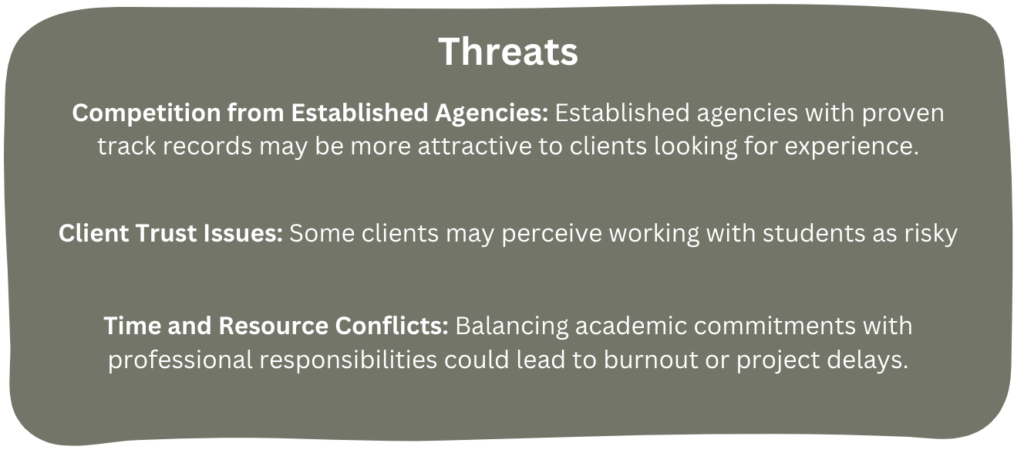
Other Possible Challenges
After receiving feedback from my lecturers, they mentioned some possible other risks around the concept of a student-led creative agency. It’s important to consider the university’s perspective on a student-led creative agency and some things to consider such as:

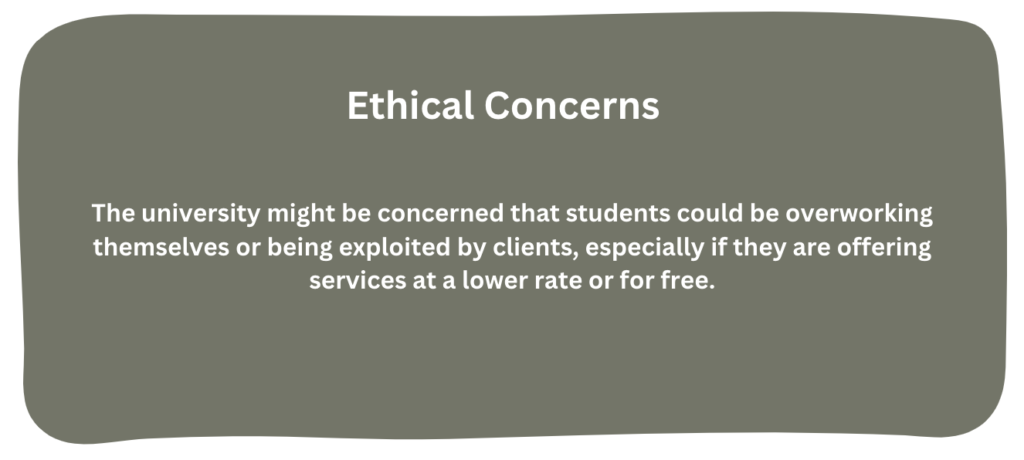
However...
To combat these possible and understandable questions, it’s important to find solutions that every party is happy with. This is why I have provided a diagram below of two solutions that could be used to ensure fairness.
The first solution is to turn the agency into a ‘Graduate-Led’ rather than a ‘Student-Led’, as this would mean that the students are no longer part of the university. The agency would then act as an independent stepping stone for graduates after finishing university to gain experience and add to their portfolio.
The second solution would be to work with the university to ensure the correct support and guidelines are in place to ensure that the students are getting the most out of the agency without feeling burnt out or stressed.
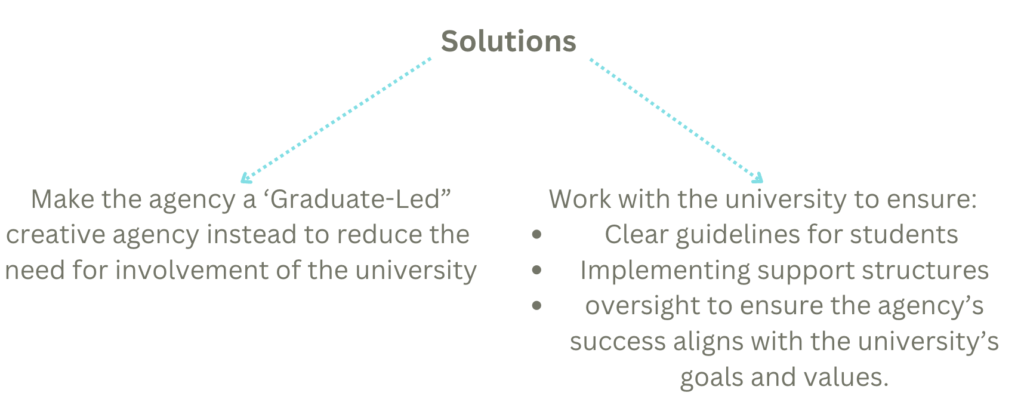
SDG 4

Unesco.org. (2023)
This project completes Sustainability Goal 4 by:
- Providing Real Experience for Students : By the time they graduate, students have already worked with clients, handled deadlines, and used the latest design tools, making them ready for the job market right away.
- Understanding Global Perspectives: By working with a variety of clients, students will be able to gain experience in adapting to different clients wants and needs.
- Working with Universities: By working closely with universities, STRIVE can tap into resources like funding, scholarships, or mentorship. Which gives students even more opportunities to learn and grow in their careers.
In summary this project actively supports SDG 4, by making education more practical, inclusive, and relevant to industry challenges. By working on real briefs with real clients, STRIVE provides students with learning that can evolve and develop throughout their careers Ultimately STRIVE creates a win-win situation where students gain critical experience, and the industry benefits from their fresh perspectives and innovative ideas.
Reflection
Upon reflection, this is the largest project that i have worked on. The many components that make up this project has enabled me to concentrate on the elements that I would like to pursue in my career, such as branding identity and user experience. By understanding the job market within the creative industry and how students feel about starting their careers, I was able to evaluate the challenges they may be facing and how my project could provide support. The completion of SDG4 shows how this project not only provides support and guidance for students but also promotes life long learning and experiences. Therefore changing the creative industry into considering new, innovative and fresh solutions.
What went well:
- I believe I conducted in-depth secondary research to fully understand the issues
- I also was able to use this to pursue the methodology created in my research proposal and conduct effective primary research
- I was able to create a strong brand identity that also translated into a unique and creative interface.
What I found difficult:
- The main thing that I struggled with in this project was the time management and sticking to my Gantt chart. As over the summer I managed to secure a full-time graphic designer position – This meant that I needed to balance my university work alongside my work projects.
Introduction and reflection: References
Bamford, A. (2023). How can the industry make design careers seem more accessible? [online] Design Week. Available at: https://www.designweek.co.uk/issues/04-september-8-september-2023/industry-design-careers-accessible/.
Newdesigners.agency. (2024). New Designers – student design agency. [online] Available at: https://newdesigners.agency/
Studio Lutalica. (2024). Studio Lutalica | Design for Feminists and Queers. [online] Available at: https://lutalica.studio/
Unesco.org. (2023). Sustainable Development Goal 4 (SDG4). [online] Available at: https://www.unesco.org/sdg4education2030/en/sdg4#:~:text=SDG4%20is%20a%20commitment%20to,a%20sustainable%20and%20equitable%20world.
Full Project Bibliography
Baddeley, A. (2013). Essentials of Human Memory (Classic Edition). Psychology Press.
Benveniste, A. and Vaux, M. (1977). Colour theory. London: Trigram Press.
Canadian Science Publishing. (2023). How to create a professional website: A guide for academics | Canadian Science Publishing. [online] Available at: https://blog.cdnsciencepub.com/how-to-create-a-professional-website-a-guide-for-academics/
Carrasco-Farré, C., Alcalde, I. and Grimaldi, D. (2022). Data analysis, modeling, and visualization in smart cities. Elsevier eBooks, [online] pp.173–195. doi: https://doi.org/10.1016/b978-0-12-821122-9.00010-5
Cornsweet, T.N. (1974). Visual perception. New York, Ny: Acad. Pr.
Digital Agency Network. (2024). Best Creative Agencies in UK. [online] Available at: https://digitalagencynetwork.com/agencies/uk/creative/
Fogden, T. (2023). What Makes a Good Website? 12 Must-Haves. [online] Tech.co. Available at: https://tech.co/website-builders/what-makes-good-website
Hashemi-Pour, C. and Churchville, F. (2024). user interface (UI). [online] App Architecture. Available at: https://www.techtarget.com/searchapparchitecture/definition/user-interface-UI#:~:text=The%20user%20interface%20(UI)%20is,the%20appearance%20of%20a%20desktop
Hedstrom, M. (2002). Archives, Memory, and Interfaces with the Past. [online] ResearchGate. Available at: https://www.researchgate.net/publication/30842592_Archives_Memory_and_Interfaces_with_the_Past
Hunter, I.M.L. (1978). Memory. Harmondsworth (Middlesex): Penguin Books.
Indeed Career Guide. (2024). What Is User Interface (UI)? [online] Available at: https://www.indeed.com/career-advice/career-development/user-interface
Laubheimer, P. (2020). Spatial Memory: Why It Matters for UX Design. [online] Nielsen Norman Group. Available at: https://www.nngroup.com/articles/spatial-memory/
Lepard, C. (2023). 5 web design tips for an outstanding site. [online] Wix Blog. Available at: https://www.wix.com/blog/5-design-tips-for-a-professional-site
Mangan, T. (2021). Visual perception: How it works & common disorders. [online] All About Vision. Available at: https://www.allaboutvision.com/eye-care/eye-anatomy/visual-perception/
Martins Zaumanis (2020). How to simply create a personal academic website and why you need one. [online] Peer Recognized. Available at: https://peerrecognized.com/website/
Mishra, S., Neeraj Kumar Singh and Rousseau, V. (2016). Memory Interfaces. Elsevier eBooks, [online] pp.275–305. doi: https://doi.org/10.1016/b978-0-12-801630-5.00007-4
Sage Journals. (2024). Qualitative Research: Sage Journals. [online] Available at: https://journals.sagepub.com/home/qrj
Simply Psychology. (2023). Visual Perception Theory In Psychology. [online] Available at: https://www.simplypsychology.org/perception-theories.html
Southernhealth.nhs.uk. (2024). Visual perception :: Southern Health NHS Foundation Trust. [online] Available at: https://www.southernhealth.nhs.uk/our-services/a-z-list-of-services/childrens-occupational-therapy-service-isle-wight/visual-perception
SUTCLIFFE, A. (2013). Human-Computer Interface Design. Springer.
The Academic Designer. (2023). How To Make A Personal Academic Website. [online] Available at: https://theacademicdesigner.com/2023/how-to-make-an-academic-website/
The Canopy®. (2021). The Canopy Studio. [online] Available at: https://thecanopy.studio/
The Interaction Design Foundation. (2016). What is User Interface (UI) Design? [online] Available at: https://www.interaction-design.org/literature/topics/ui-design

